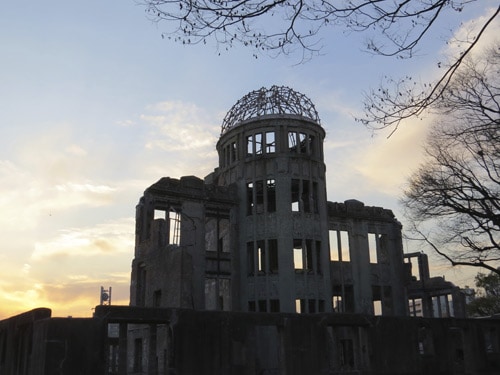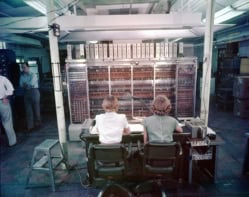
By Hamish Johnston
Today marks the 70th anniversary of the bombing of Hiroshima – the first time that a nuclear weapon was used in war. Many argue that the bombing of Hiroshima, and three days later Nagasaki, was a necessary evil that saved hundreds of thousands of lives by ending the war and avoiding an allied invasion of Japan.
Over on The Nuclear Secrecy Blog, the science historian Alex Wellerstein asks “Were there alternatives to the atomic bombings?”. Wellerstein argues that the choice facing the US in 1945 was not as simple as whether to bomb or to invade. He points out that some physicists working on the Manhattan Project – which built the bombs – argued for a “technical demonstration” of the weapons.
In June 1945 the Nobel laureate James Franck and some colleagues wrote a report that argued that the bomb should first be demonstrated to the world by detonating it over a barren island. Wellerstein surmised that “If the Japanese still refused to surrender, then the further use of the weapon, and its further responsibility, could be considered by an informed world community”. Another idea being circulated at the time was a detonation high over Tokyo Bay that would be visible from the Imperial Palace but would result in far fewer casualties than at Hiroshima, where about 140,000 people were killed.
On the other hand, Wellerstein points out that Robert Oppenheimer and three Nobel laureates wrote a report that concluded “we can propose no technical demonstration likely to bring an end to the war; we see no acceptable alternative to direct military use”. This report was written for a US government committee, which decided to use the weapon against a “dual target” of military and civilian use.
This morning in Hiroshima there was a ceremony to remember those who died in the attack and its aftermath. Addressing a crowd of 40,000, Hiroshima’s mayor Kazumi Matsui pointed out that “Our world still bristles with more than 15,000 nuclear weapons”. Indeed, at least nine countries have nuclear weapons and Matsui added “We now know about the many incidents and accidents that have taken us to the brink of nuclear war or nuclear explosions. Today, we worry as well about nuclear terrorism.”
A question that has been asked in the run-up to the anniversary is whether we have avoided nuclear war over the past 70 years because we are acutely aware of the horrors of Hiroshima and Nagasaki or because we have simply been lucky? Furthermore, if we allow Hiroshima and Nagasaki to be forgotten – or our luck runs out – will we follow a path to self-destruction?
As Matsui pointed out, there are thousands of weapons worldwide today and they are much more powerful than the bomb that destroyed Hiroshima. This is illustrated rather chillingly in this infographic by Maximilian Bode, which shows that self-destruction is still a possibility.
The idea of advanced civilizations destroying themselves is relevant beyond our world. One resolution of the Fermi paradox – which asks if advanced alien civilizations exist, then why haven’t we noticed them already? – is that once a civilization has the capacity to destroy itself, it is very likely to do so.
In the preprint “Observational signatures of self-destructive civilisations”, the UK-based astronomers Adam Stevens, Duncan Forgan and Jack O’Malley-James “consider a variety of scenarios in which humans could extinguish their own technological civilization”. They then try to work out whether these cataclysms would produce signature signals that could be detected over interstellar distances. Nuclear annihilation is one of the scenarios discussed. Let’s hope that the lessons learned from Hiroshima and Nagasaki ensure that the Earth will not be sending out such signals in the future.



